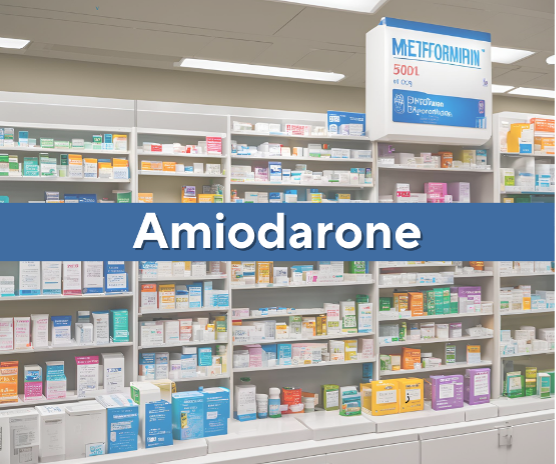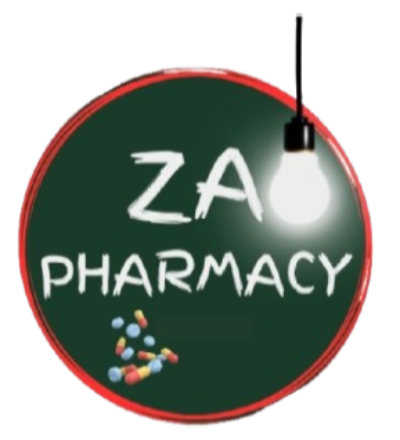Za Pharmacy
Drugs, Supplies and Delivery
Amiodarone
Amiodarone is a potent class III antiarrhythmic medication widely used to treat and prevent life-threatening ventricular and supraventricular arrhythmias. Despite its efficacy, amiodarone has a complex pharmacokinetic profile and a significant side effect profile, requiring careful monitoring. This article synthesizes information from the British National Formulary (BNF), Lippincott Textbook of Pharmacology, and Lange Basic & Clinical Pharmacology to provide a detailed overview of amiodarone, including its mechanism, uses, dosing, side effects, precautions, and drug interactions.
Amiodarone is a multi-channel blocker with effects on sodium, potassium, and calcium channels, as well as non-competitive beta-blocking activity. Its primary mechanisms include:
- Potassium Channel Blockade:
- Prolongs the action potential duration and refractory period by blocking potassium channels, particularly the rapid component of the delayed rectifier potassium current (IKr) (Lippincott, Lange).
- Sodium Channel Blockade:
- Slows conduction velocity by inhibiting sodium channels during phase 0 of the cardiac action potential (BNF).
- Calcium Channel Blockade:
- Reduces calcium influx, contributing to its antiarrhythmic effects (Lippincott).
- Beta-Blocking Activity:
- Non-competitively inhibits beta-adrenergic receptors, reducing sympathetic stimulation and heart rate (Lange).
Amiodarone’s broad-spectrum activity makes it effective for a wide range of arrhythmias.
- Ventricular Arrhythmias:
- Used to treat and prevent life-threatening ventricular tachycardia (VT) and ventricular fibrillation (VF) (BNF).
- Atrial Fibrillation (AF) and Atrial Flutter:
- Effective in maintaining sinus rhythm in patients with AF or atrial flutter (Lippincott).
- Supraventricular Tachycardia (SVT):
- Used for acute and chronic management of SVT (Lange).
- Loading Dose (Oral):
- 200 mg three times daily for 1 week, then 200 mg twice daily for 1 week, followed by a maintenance dose of 200 mg once daily (BNF).
- Loading Dose (Intravenous):
- 5 mg/kg over 20–120 minutes, followed by 1.2 g over 24 hours via continuous infusion (Lippincott).
- Maintenance Dose:
- 100–200 mg once daily (oral) or 0.5–1 mg/min (IV) (Lange).
Administration:
- Oral amiodarone should be taken with food to improve absorption.
- Regular monitoring of thyroid, liver, and pulmonary function is essential due to the risk of long-term side effects (BNF).
- Common: Nausea, vomiting, fatigue, and photosensitivity (Lippincott).
- Serious:
- Pulmonary Toxicity: Interstitial pneumonitis, pulmonary fibrosis.
- Thyroid Dysfunction: Hypothyroidism or hyperthyroidism.
- Hepatotoxicity: Elevated liver enzymes, hepatitis.
- Cardiac Effects: Bradycardia, QT prolongation, and torsades de pointes (Lange).
- Pulmonary Disease: Use with caution in patients with pre-existing lung disease due to the risk of pulmonary toxicity (BNF).
- Thyroid Dysfunction: Monitor thyroid function regularly; amiodarone contains iodine and can cause hypo- or hyperthyroidism (Lippincott).
- Liver Impairment: Regular liver function tests are required due to the risk of hepatotoxicity (Lange).
- Pregnancy: Use only if benefits outweigh risks; amiodarone can cause fetal harm (BNF).
- Digoxin: Amiodarone increases digoxin levels; reduce digoxin dose by 50% (Lippincott).
- Warfarin: Amiodarone increases warfarin levels, increasing the risk of bleeding; monitor INR closely (Lange).
- Beta-Blockers and Calcium Channel Blockers: Increased risk of bradycardia and AV block (BNF).
- CYP3A4 Inhibitors (e.g., ketoconazole): Increase amiodarone levels, raising the risk of toxicity (Lippincott).
Amiodarone is the generic name for this medication. It is marketed under the brand name Cordarone® in some regions. Generic versions are widely available and cost-effective.

